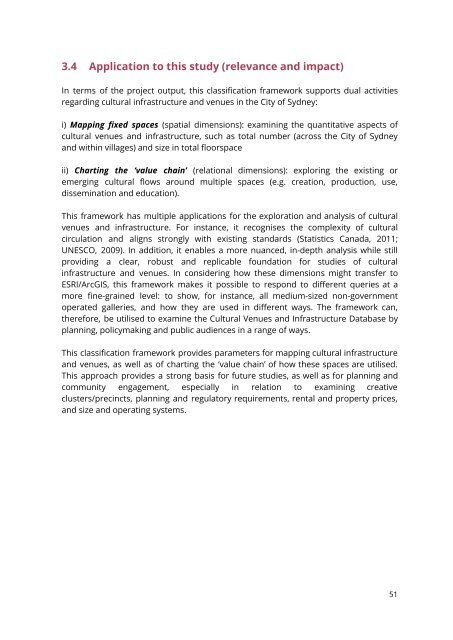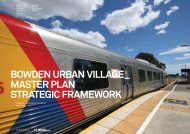MAPPING CULTURE
Mapping-Culture-Venues-and-Infrastructure-in-the-City-of-Sydney
Mapping-Culture-Venues-and-Infrastructure-in-the-City-of-Sydney
Create successful ePaper yourself
Turn your PDF publications into a flip-book with our unique Google optimized e-Paper software.
3.4 Application to this study (relevance and impact)<br />
In terms of the project output, this classification framework supports dual activities<br />
regarding cultural infrastructure and venues in the City of Sydney:<br />
i) Mapping 〠ǂxed spaces (spatial dimensions): examining the quantitative aspects of<br />
cultural venues and infrastructure, such as total number (across the City of Sydney<br />
and within villages) and size in total floorspace<br />
ii) Charting the ‘value chain’ (relational dimensions): exploring the existing or<br />
emerging cultural flows around multiple spaces (e.g. creation, production, use,<br />
dissemination and education).<br />
This framework has multiple applications for the exploration and analysis of cultural<br />
venues and infrastructure. For instance, it recognises the complexity of cultural<br />
circulation and aligns strongly with existing standards (Statistics Canada, 2011;<br />
UNESCO, 2009). In addition, it enables a more nuanced, in-depth analysis while still<br />
providing a clear, robust and replicable foundation for studies of cultural<br />
infrastructure and venues. In considering how these dimensions might transfer to<br />
ESRI/ArcGIS, this framework makes it possible to respond to different queries at a<br />
more fine-grained level: to show, for instance, all medium-sized non-government<br />
operated galleries, and how they are used in different ways. The framework can,<br />
therefore, be utilised to examine the Cultural Venues and Infrastructure Database by<br />
planning, policymaking and public audiences in a range of ways.<br />
This classification framework provides parameters for mapping cultural infrastructure<br />
and venues, as well as of charting the ‘value chain’ of how these spaces are utilised.<br />
This approach provides a strong basis for future studies, as well as for planning and<br />
community engagement, especially in relation to examining creative<br />
clusters/precincts, planning and regulatory requirements, rental and property prices,<br />
and size and operating systems.<br />
51



